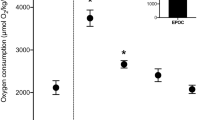Summary
Ventilation frequency, volume, oxygen uptake, and oxygen transport by the blood have been studied in unrestrained octopus,Octopus vulgaris before, during and after recovery from 20 min of enforced activity. Exercise increased oxygen consumption 2.8 fold. The percentage utilisation of oxygen from the branchial water is maintained or increased at around 35% during activity and the calculated ventilation volume increases by 3 times. Prior to exercise the hemocyanin in arterial blood is 98% saturated and there is 83% utilisation of the oxygen in the blood. During activity there is remarkably little change in blood parameters so that the hemocyanin in the arterial blood remains at 96% saturation and oxygen utilisation is 90%. Cardiac output was calculated to have risen 2.5 fold during activity. As theP O 2 gradients across the gill do not change significantly during exercise the major adaptation which can account for an increase in oxygen consumption must be a 3 fold increase in the transfer factor. At rest 22% of the total CO2 present in the blood is excreted during its passage through the gills and this rises to 32% during activity. There is no accumulation of CO2 and only a slight acidification of the blood during activity. A significant respiratory and metabolic acidosis is avoided and the hemocyanin continues to function normally.
Similar content being viewed by others
References
Booth CE, McMahon BR, Pinder AW (1982) Oxygen uptake and the potentiating effects of increased haemolymph lactate on oxygen transport during exercise in the blue crab,Callinectes sapidus. J Comp Physiol 148:111–121
Bridges CR, Bicudo JEPW, Lykkeboe G (1979) Oxygen content measurement in blood containing haemocyanin. Comp Biochem Physiol 62A:457–462
Cameron JN (1971) Rapid method for determination of total carbon dioxide in small blood samples. J Appl Physiol 31:632–634
Cameron JN (1979) Excretion of CO2 in water-breathing animals — a short review. Marine Biol Lett 1:3–13
Houlihan DF, Innes AJ, Wells MJ, Wells J (1982) Oxygen consumption and blood gases ofOctopus vulgaris in hypoxic conditions. J Comp Physiol 148:35–40
Houlihan Df, Mathers E, El Haj A (1984) Walking performance and aerobic and anaerobic metabolism ofCarcinus maenas (L.) in sea water at 15 °C. J Exp Mar Biol Ecol 74:211–230
Johansen K (1982) Respiratory gas exchange of vertebrate gills. In: Houlihan DF, Rankin JC, Shuttleworth TJ (eds) Gills. Cambridge University Press, Cambridge, pp 99–128
Johansen K, Lenfant C (1966) Gas exchange in the cephalopodOctopus dofleini. Am J Physiol 210:901–918
Johansen K, Brix O, Lykkeboe G (1982) Blood gas transport in the cephalopod,Sepia officinalis. J Exp Biol 99:331–338
Jones Dr, Randall DJ (1978) The respiratory and circulatory systems during exercise. In: Hoar WS, Randall DJ (eds) Fish physiology, vol VII. Academic Press, New York, pp 425–502
Kicenuik JW, Jones DR (1977) The oxygen transport system in trout (Salmo gairdneri) during sustained exercise. J Exp Biol 69:247–260
Lenfant C, Johansen K (1965) Gas transport by the haemocyanin containing blood of the cephalopodOctopus dofleini. Am J Physiol 209:991–998
Lykkeboe G, Johansen K (1982) A cephalopod approach to rethinking about the importance of the Bohr and Haldane effects. Pacific Sci 36:305–313
Lykkeboe G, Brix O, Johansen K (1980) Oxygen-linked CO2 binding independent of pH in cephalopod blood. Nature 287:330–331
McMahon BR (1982) Oxygen uptake and acid-base balance during activity in decapod crustaceans. In: Herreid CF, Fourtner CR (eds) Locomotion and energetics in arthropods. Plenum Press, New York, pp 299–335
O'Dor RK (1982) Respiratory metabolism and swimming performance of the squidLoligo opalescens. Can J Fish Aquat Sci 39:580–587
Strickland JDH, Parsons TR (1972) A practical handbook of sea water analysis. Bull Fish Res Bd Can 167:310 pp
Truchot JP (1971) Fixation de l'oxygène par le sérum deCarcinus maenas (L.) (Crustacé Decapode Branchyoure). CR Acad Sci [D] (Paris) 272:984–987
Truchot JP (1976) Carbon dioxide combining properties of the blood of the shore crabCarcinus maenas (L.): carbon dioxide solubility coefficient and carbonic acid dissociation constants. J Exp Biol 64:45–57
Tucker VA (1967) Method for oxygen content and dissociation curves on microlitre blood samples. J Appl Physiol 23:410–414
Wells MJ (1979) The heartbeat ofOctopus vulgaris. J Exp Biol 78:87–104
Wells MJ, Wells J (1982) Ventilatory currents in the mantle of cephalopods. J Exp Biol 99:315–330
Wells MJ, Wells J (1983) The circulatory response to acute hypoxia inOctopus. J Exp Biol 104:59–71
Wells MJ, Wells J (1984) The effects of reducing gill area on the capacity to regulate oxygen uptake and on metabolic scope in a cephalopod. J Exp Biol 108:393–401
Wells MJ, O'Dor RK, Mangold K, Wells J (1983) Oxygen consumption and movement byOctopus. Mar Behav Physiol 9:289–303
Wood CM, McMahon BR, McDonald DG (1979) Respiratory gas exchange in the resting starry flounder,Platichthys stellatus: a comparison with other teleosts. J Exp Biol 78:167–179
Wyman J (1964) Linked functions and reciprocal effects in haemoglobin: a second look. Adv Prot Chem 19:223–986
Author information
Authors and Affiliations
Rights and permissions
About this article
Cite this article
Houlihan, D.F., Duthie, G., Smith, P.J. et al. Ventilation and circulation during exercise inOctopus vulgaris . J Comp Physiol B 156, 683–689 (1986). https://doi.org/10.1007/BF00692746
Accepted:
Issue Date:
DOI: https://doi.org/10.1007/BF00692746




